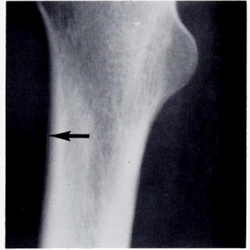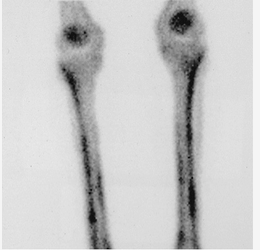hypertrophic osteoarthropathy
- related: Pulmonary Diseases
- tags: #literature #pulmonology #oncology
The chest radiograph shows a mass in the right lower lobe (Figure 3). In a smoker, this suggests the diagnosis of lung cancer. Pain and swelling over the long bones would most likely be due to hypertrophic osteoarthropathy (HOA). The 99mTc bone scan is the most sensitive diagnostic test, the isotope concentrating in areas of the increased osteoblastic activity and subperiosteal new bone formation that characterizes the condition (Figure 2). The diagnosis may also be established when radiography shows new bone proliferation in the long bones, especially the radius, ulna, tibia, and fibula (Figure 4). Although the 18FDG-PET scan will show hypermetabolic activity in the same areas, this test is neither as sensitive nor specific in the diagnosis of HOA as the radionuclide scan.

Image of tibia showing subperiosteal new bone formation (arrow).

99mTc bone scan showing increased activity in the tibiae.
A rare primary inherited form of HOA usually has autosomal dominant transmission. The secondary form is usually associated with lung and pleural conditions, most often non-small cell lung cancer; patients with malignant mesothelioma and benign fibrous tumors of the pleura may have HOA. HOA is also associated with other lung diseases, including pulmonary fibrosis and bronchiectasis, cyanotic congenital heart disease, gastrointestinal tumors, cirrhosis, and inflammatory bowel disease. Patients who have clubbing associated with nonmalignant disorders rarely have HOA. HOA does not preclude curative surgery of lung cancer; these patients should have the same staging evaluation and treatment as patients who do not have HOA, and resection of the tumor often leads to remission of osteoarthropathy. HOA without clubbing may occasionally be the presenting symptom in patients with lung cancer, as in this case.
The pathogenesis of HOA is not known but probably involves humoral factors that promote growth of vascular connective tissue and new bone formation. Neural factors are also probably involved, as some cases of vagotomy on the side of an inoperable lung cancer have led to remission of osteoarthropathy.
HOA sometimes resembles rheumatoid arthritis clinically, but not in this case where respiratory symptoms and not joint pains and swelling are most prominent. Serum anti-CCP antibodies are highly specific for the diagnosis and useful to predict the development of more severe disease but are not increased in HOA. Serum parathyroid hormone-related protein accounts for hypercalcemia, the most common paraneoplastic syndrome occurring in patients with squamous cell carcinoma of the lung, but this patient has no symptoms of hypercalcemia.1